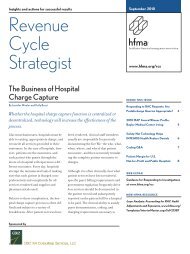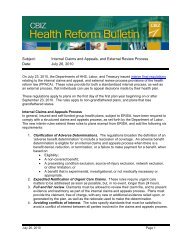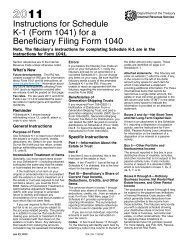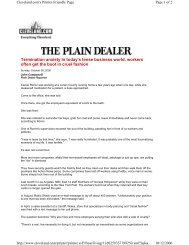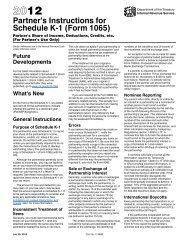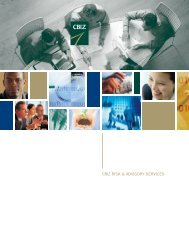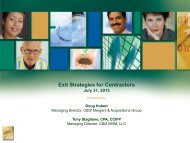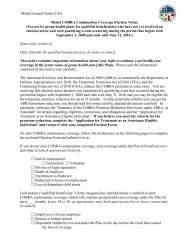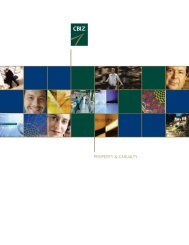download slides - CBIZ
download slides - CBIZ
download slides - CBIZ
You also want an ePaper? Increase the reach of your titles
YUMPU automatically turns print PDFs into web optimized ePapers that Google loves.
Federal Tax Incentives for Architects, Engineers and<br />
Design-Build Contractors<br />
June 5, 2013<br />
Presented by<br />
John Armour, CPA, CCIFP<br />
Managing Director, <strong>CBIZ</strong> MHM, LLC<br />
Robert Gellman, CPA<br />
Managing Director, <strong>CBIZ</strong> MHM, LLC National Tax Office<br />
Michael Silvio, CPA<br />
Managing Director, <strong>CBIZ</strong> MHM, LLC
Trouble Shooting<br />
Troubleshooting Tips<br />
No Audio?<br />
• This is an audio only event. Ensure that your computer speakers are<br />
turned on and that the volume is appropriately set.<br />
• Check to ensure that audio streaming is enabled on your computer<br />
If the presentation<strong>slides</strong> stop advancing during the presentation<br />
• Close out of the presentation and re-launch the webcast<br />
If you are still having audio or other technical difficulty<br />
• Check with your IT personnel at your firm to ensure that this event is<br />
not being blocked by a firewall.<br />
• Contact LearnLive support by clicking on the “Support” tab.
How to submit questions during the presentation?<br />
Click the Q&A button in the toolbar above and then Click<br />
Then type your question in the box and click ‘send”.<br />
If possible, we will answer questions as we go. We have also built in some time for<br />
additional questions at the end of the presentation.
Continuing Professional Education<br />
• There will be a total of 4 participation pop-up markers<br />
during the event (i.e., about 1 every 15 minutes)<br />
• To obtain CPE, you must click “OK” on 75% of the<br />
participant pop-up markers<br />
• If you did not register to receive CPE for this event, ignore<br />
the pop-up markers
Circular 230 Notice<br />
Any tax advice contained in this program is not intended to<br />
be used and cannot be used for the purposes of avoiding<br />
any penalties that may be imposed by the Internal Revenue<br />
Code.
Agenda<br />
• § 179D-Energy Efficient Building Deduction<br />
• § 199-Domestic Production Activities Deduction<br />
• § 41-Research and Development Tax Credit<br />
• Summary/Key Takeaways<br />
• Q&A
Robert C. Gellman, CPA<br />
Mr. Gellman is a Managing Director of <strong>CBIZ</strong> MHM, LLC and a Shareholder of Mayer Hoffman<br />
McCann P.C. With more than 25 years of tax and financial advisory experience, Mr. Gellman helps<br />
a broad range of privately held clients and high net worth individuals to develop tax and financial<br />
strategies consistent with their financial goals. Mr. Gellman has authored a book and workshop on<br />
the subject entitled: Seven Keys to Unlocking the Door to Your Dreams: Exit Strategies For<br />
Business Owners. As a reflection of his broad interests and capabilities, Mr. Gellman is also leads<br />
the San Diego and Orange County Not-for-Profit and Code Section 179D Energy Efficient Design<br />
Deduction Study tax practice areas.<br />
Mr. Gellman uses his experience in the estate planning and charitable giving areas to address the<br />
personal and philanthropic interests of his individual and business owner clients. He specializes in<br />
exit strategy and succession planning, longer term tax and financial strategies, personal<br />
CFO/trusted advisor services and not-for-profit organization taxation and governance. His specific<br />
area of expertise, and his passion, hones in on the long-term planning needs of privately held<br />
business owners form a myriad of industries.<br />
Mr. Gellman has a Masters Degree in Taxation from San Diego State University, Bachelor Degrees<br />
in Accounting and Finance from the University of Southern California and the Certificate in<br />
International Business from the University of San Diego. He is a member of the firm’s Individual<br />
Wealth Planning and Not-For-Profit Technical Committees. Mr. Gellman serves on the Advisory<br />
Boards of client companies, and on the board of directors of the San Diego chapter of the USC<br />
Marshall School of Business, the USC Trojan Club of San Diego and the World Trade Center San<br />
Diego. Mr. Gellman is an active member of the Corporate Directors Forum, Business Executives<br />
Council and Estate Planning Council of San Diego.
John R. Armour, CPA CCIFP<br />
Having practiced for more than 30 years with specialization in the construction and real estate industry, John<br />
Armour is nationally recognized as leading authority and expert in construction accounting and taxation. John<br />
is licensed to practice as a CPA in Colorado & New Mexico and is a Managing Director in <strong>CBIZ</strong> MHM, LLC<br />
(<strong>CBIZ</strong>) where he serves as its western region national AEC industry services director.<br />
Serving as chair of the Current Tax Issues sub-committee of the Tax and Fiscal Affairs Committee of the<br />
Associated General Contractors of America, John is responsible for leadership of tax agenda initiatives for the<br />
construction industry on a national level including legislative revisions to tax code and working with the IRS<br />
and Treasury on regulatory improvements. He also has been highly involved with accounting standards<br />
projects such as revenue recognition working directly with the FASB / IASB staff and board members.<br />
John is a frequent speaker to construction trade associations and conferences. He served as chair of the<br />
AICPA National Construction Industry Conference planning committee from 2002 - 2005, the largest annual<br />
educational opportunity for CPAs serving the construction industry in public and private capacities. He is an<br />
author and instructor of three construction industry continuing education classes that have been presented in<br />
over 40 states. John also is on the editorial board of the Journal of Construction Accounting and Taxation.<br />
He is active in construction trade associations including being a founding member of the Colorado Chapter of<br />
the Construction Financial Management Association. John has served on various committees and advisory<br />
capacities and presently serves on the legislative committees of both the Colorado Contractors Association<br />
and Associated General Contractors Colorado Chapter. Additional construction industry involvement includes<br />
the Associated Building Contractors, Professionals for Colorado Contractors Council, and Rocky Mountain<br />
Surety Association.
Michael Silvio, CPA<br />
Michael Silvio is Managing Director with <strong>CBIZ</strong> MHM, LLC. He leads the firm’s National Federal<br />
Credits and Incentives Practice and is located in Irvine, California. His focus is on federal incentives<br />
such as the Research & Development (R&D) Tax Credit, the Domestic Production Deduction-Sec.<br />
199, Energy Incentives and the like.<br />
Michael has more than 22 years of experience in public accounting and tax and has served a variety<br />
of businesses in the manufacturing, construction, professional service and not-for-profit industries.<br />
Michael’s primary focus is in tax credits and tax incentives areas. He has conducted over 350<br />
research credit studies along with many Sec. 199 studies for numerous companies in various<br />
industries. He has served as a representative before the IRS and state taxing authorities to support<br />
and defend numerous research credit claims for taxpayers.<br />
He also has experience in financial accounting, reporting and management, auditing, and individual<br />
and business income tax. Michael has supervised compilations, audits and reviews for various<br />
clients, including small and medium sized businesses, in addition to providing income tax planning,<br />
consulting and compilation services.<br />
Michael is a CPA certified in California. He is a member of the American Institute of Certified Public<br />
Accountants and the California Society of Certified Public Accountants. He has a Bachelor of Arts in<br />
business administration with an emphasis in accounting from California State Polytechnic University<br />
in Pomona. Throughout his career he has authored several publications and conducted numerous<br />
presentations on current tax legislation, R&D tax credit, energy incentive issues and other tax related<br />
business incentives. He has also spoken to organizations such as the California Society of CPA’s, the<br />
National Association of Manufacturers, the R&D Credit Coalition in Washington, D.C., and the<br />
American Bar Association.
§179D Energy Efficient<br />
Commercial Building Design
Primary IRS Guidance<br />
• Internal Revenue Code §179D<br />
• Treasury Regulations have not been issued<br />
• Other IRS Technical Guidance<br />
• Notice 2006-52<br />
• Notice 2008-40<br />
• Rev Proc 2011-14<br />
• Notice 2012-26<br />
General Rules, Partial Deductions,<br />
Specified Energy Saving Percentages<br />
Rules Covering Government and<br />
Public Buildings, Alternative Energy<br />
Saving Percentages<br />
Changes in the Method of Accounting<br />
for Building Assets<br />
Additional Energy Saving Percentages
Other Areas of Guidance<br />
• Engineer’s Technical Requirements<br />
• National and In-State Licensing Standards<br />
• Approved Performance Rating Methodology<br />
• Energy Efficiency Rating Standards<br />
• Reference Building Standards<br />
• Prescribed Modeling Software<br />
• Field Inspections<br />
• Report Standards
Summary Of Energy Saving Percentages<br />
179D Rules<br />
Permanent/Fully<br />
Qualifying Property<br />
Permanent/Fully Qualifying Property<br />
Interim/Partially<br />
Qualifying Property<br />
(Lighting Only)<br />
IRS Notice<br />
2006-52, 2008-40, 2012-<br />
26 2006-52 2008-40 2012-26<br />
2006-52, 2008-40 and<br />
2012-26<br />
Requirement<br />
Percent reduction in energy cost<br />
Percent reduction in lighting<br />
power density<br />
Building Envelope 50% 16 2/3% 10% 10% N/A<br />
HVAC 50% 16 2/3% 20% 15% N/A<br />
Interior Lighting 50% 16 2/3% 20% 25%<br />
Generally 25% (50% for<br />
warehouses)<br />
Effective For<br />
Property Placed In<br />
Service<br />
Jan 1, 2006- through<br />
Dec 31, 2013<br />
Jan 1, 2006 through<br />
Dec 31, 2008<br />
Jan. 1, 2006 through<br />
Dec. 31, 2013<br />
Feb. 24, 2012<br />
through<br />
Dec. 31, 2013<br />
Jan. 1, 2006 through<br />
Dec. 31, 2013
Deductions Available If Energy Efficiencies<br />
Have Been Met<br />
• Lighting - $.60 per square foot<br />
– Adjusted under certain circumstances<br />
• HVAC - $.60 per square foot<br />
• Building Envelope - $.60 per square foot<br />
• Limited to Cost Incurred<br />
• Example: 100,000 Affected Sq. Ft. X $1.80 = $180,000 Deduction
For Commercial Buildings<br />
• Available to Owners of Commercial Buildings and Parking<br />
Garages for Assets Placed in Service After 1/1/2006<br />
• Deductions Are Applicable to the Year in Which the Property is<br />
Placed In Service<br />
• Depreciation Methods Adopted in Prior Years Subject to<br />
Change Within Current Year Tax Returns<br />
• 179D and Cost Segregation<br />
– Lighting and HVAC systems that do not qualify for cost segregation<br />
may qualify for 179D
Special Rule for Government-Owned Buildings<br />
Buildings<br />
• Property Owned by a Federal, State, or Local<br />
Government or Political Subdivision<br />
• Allocable to the Person Primarily Responsible for<br />
Designing the Property<br />
• During the Year in Which the Property is Placed In<br />
Service<br />
• May Require a Signed Acknowledgement Form Which<br />
May Allocate the Deduction at the Owner’s Discretion
Certification & Documentation<br />
• In-State Licensed Engineer<br />
• Obtains Design Plans and Specifications<br />
• Applies Performance Rating Methodology<br />
• Performs Field Inspection as Prescribed<br />
• Provides Data Summary and Model Output<br />
• After the Property Is Placed In Service<br />
• Provides A Statement That the Study Has Been<br />
Conducted Pursuant to Prescribed Guidelines
Claiming the §179D Deduction<br />
• Confirmation Of Procedural Compliance with All Areas of<br />
Technical Guidance<br />
• Validation of Reporting Period<br />
• Compilation of All Audit Support File Documentation<br />
• Validation of State Deductibility<br />
• For Commercial Building Owners - Filing For a Change in<br />
Method of Accounting for Building Assets within Current Year<br />
Returns<br />
• For Primary Design Contractors of Government Owned<br />
Buildings - Filing of Amended and Current Year Returns
§199 Domestic Production<br />
Activities Deduction (DPAD)
§199 Overview – Tax Benefit<br />
• Deduction equal to the smallest of:<br />
– 9% of taxable income<br />
– 9% of qualified production activities income (QPAI)<br />
– 50% of W-2 wages allocable to domestic production gross<br />
receipts (DPGR)<br />
• Qualifying activity<br />
– Construction performed in the United States<br />
– Engineering or Architectural services performed in the united<br />
states
Taxable Income Limitation<br />
• Taxable income without regard to §199 deduction<br />
• §199 deduction cannot create or increase an NOL<br />
– NOL carryback/carryover under §172 regs computed without<br />
regard to §199 deduction<br />
– Exception for deduction allocated to non-consolidated<br />
member of a §199 Expanded Affiliated Group (EAG)<br />
Note – If your state income tax is based upon Federal taxable income the<br />
deduction will result in both Federal and State tax savings
QPAI Determination<br />
• Determine Domestic Production Gross Receipts<br />
(DPGR)<br />
• Less Cost of Goods Sold allocable to DPGR<br />
• Less Other Expenses directly allocable to DPGR<br />
• Less Indirect Expenses (remaining G&A) apportioned<br />
to DPGR
Qualifying Activities – Engineering and<br />
Architectural Services<br />
• Required to be in an engineering and architectural<br />
trade or business on a regular and ongoing basis<br />
– Not required to be primary or only trade or business<br />
– Must be engineering and architectural under NAICS code<br />
• Services must be performed in the U.S. for U.S.<br />
construction projects<br />
• Project need not be undertaken or completed<br />
• De minimis rules
Qualifying Activities – Engineering and<br />
Architectural Services<br />
• Qualifying services<br />
– Engineering includes<br />
• Any professional services requiring engineering education,<br />
training and experience<br />
• Responsible supervision of construction to assure compliance<br />
with plans, specifications, and design<br />
– Architectural includes<br />
• Any professional services<br />
– Consultation, planning aesthetics and structural design.<br />
– Administrative support services<br />
Note – Services such as entitlement services do not qualify.
Qualifying Activities – Construction<br />
• Construction performed in the U.S. with respect to real property<br />
– Required to be in a construction trade or business on a regular and<br />
ongoing basis<br />
• Not required to be primary or only trade or business<br />
• Must be construction under NAICS code<br />
– Item is the construction project<br />
– Proceeds from sale of land are excluded<br />
• Land safe harbor provided<br />
• Grading, demolition, clearing, excavation and other activities may be<br />
construction<br />
– Make reasonable inquiry or reasonable determination<br />
– DPGR includes construction warranties
What is Real Property?<br />
• Buildings (including structural components of such<br />
buildings)<br />
• Inherently permanent structures other than<br />
machinery<br />
• Inherently permanent land improvements<br />
• Oil and gas wells, and infrastructure<br />
• IDC
What is Real Property ?<br />
• Structural components of buildings and inherently<br />
permanent structures include property such as walls,<br />
partitions, doors, wiring, plumbing, central air<br />
conditioning and heating systems, pipes and ducts,<br />
elevators and escalators, and other similar property.<br />
• Infrastructure includes roads, power lines, water<br />
systems, railroad spurs, communication facilities,<br />
sewers, sidewalks, cable, and wiring.<br />
• Term also includes inherently permanent oil and gas<br />
platforms
Qualifying Activities – Construction<br />
• Real Property not Personal Property<br />
• Substantial Renovation vs. Repair<br />
• U.S. Project<br />
• Other Issues<br />
– Tangential services performed independently<br />
– Land improvements
Qualifying Activities – Construction<br />
• “Substantial renovation” means the renovation of a<br />
major component or substantial structural part of real<br />
property that<br />
– Materially increases the value of the property<br />
– Substantially prolongs the useful life of the property, or<br />
– Adapts the property to a new or different use
Gibson and Associates, Inc. v. Commissioner<br />
136 T.C. No 10 February 24, 2011<br />
• Best Practices learned from Gibson<br />
– Avoid terms in documentation that are typical of repairs and<br />
maintenance regulations<br />
• Use surface restoration vs. painting<br />
– Define the “Item”<br />
– Where possible, modify the owner contract or PO so that the<br />
owner attests that they are capitalizing the cost of the project<br />
– Understand IRC 263(a) – Court overturned the government<br />
position that they could rely solely on section 199 Code and<br />
Regulations
Gibson and Associates, Inc. v. Commissioner<br />
136 T.C. No 10 February 24, 2011<br />
• Best Practices learned from Gibson<br />
– Federal Highway Act – 23 US C Section 116 – Federal funds<br />
are a cost effective way of extending the useful life of a<br />
project<br />
– Gibson ruled that a 3-year life extension or 5% of FMV<br />
increase resulted in capitalization treatment<br />
– Other criteria for qualification<br />
• Adapt to new use<br />
• Part of new construction<br />
– Subcontractors can include the work of others<br />
– Use the “Gibson Spreadsheet”
§ 41Research and Development<br />
Tax Credit
The Federal Research Credit : Technical Aspects<br />
Governed by IRC Sections 41 and 174<br />
• Federal credit is 20% of qualified costs over baseline for<br />
activities performed with U.S.<br />
•Various states have various credit provision for R & D<br />
performed within the state<br />
Methods of calculation:<br />
•Traditional Method<br />
•Alternative Simplified Credit (Fed only)<br />
Reduced credit can be elected (IRC 280C)<br />
• Fed: Can be carried back 1 year and carried forward 20<br />
years; for 2010, carry back is 5 years as ESB credit<br />
• Carry back and carry forward provision vary by state
The Research and Development Tax Credit<br />
• The Four Part Test (See next slide)<br />
• The Section 174 Test (IRC 174)<br />
– In Connection with a Trade or Business<br />
– Discover information to Eliminate Uncertainty-Experimental in<br />
Nature
What Qualifies as Research? – The Four Part Test<br />
Permitted Purposes<br />
The activity must relate to a new or improved<br />
business component’s:<br />
• Function ▪ Performance<br />
• Reliability ▪ Quality<br />
“Business component” = product or process<br />
Technological in Nature<br />
The activity performed must fundamentally<br />
rely on principles of:<br />
• Physical science<br />
• Biological science<br />
• Computer science<br />
• Engineering<br />
Elimination of Uncertainty<br />
The activity must be intended to discover<br />
information to eliminate uncertainty concerning<br />
the capability or method for developing or<br />
improving a product or process, or the<br />
appropriateness of the product design.<br />
Process of Experimentation<br />
Substantially all (80%) of the activities must be<br />
elements of a process of experimentation<br />
involving:<br />
• Evaluation of alternatives<br />
• Confirmation of hypotheses through trial & error,<br />
testing and or modeling<br />
• Refining or discarding of the hypotheses
Research and Development Tax Credit:<br />
Qualified Costs Included<br />
‣ Wages, excluding any fringe benefits, of employees directly<br />
engaged in the research, or that provide direct supervision<br />
or support of the research. This amount can be found on<br />
line 1 of the form W-2.<br />
‣ Supplies, excluding land and depreciable property. These<br />
supplies must be consumed in the performance of the<br />
research activities. Certain overhead costs can be included<br />
such as rent and utilities and telephone expenses.<br />
‣ Outside services incurred during the research process.<br />
Only 65% of these costs are eligible for the credit. These<br />
costs include outside consultants, software programmers<br />
and engineers, outside tool and die makers, etc.
R & D Credit Scope Limitations<br />
To take the credit, it must not be “funded;” This involves two concepts:<br />
‣ The business must be at risk on its investment in the research and<br />
‣ The business must retain substantial rights in the results of the research<br />
‣ See Field Attorney Advice (FAA) 20121401F
R & D Credit: Industry Opportunities-<br />
Architectural and Engineering<br />
• Design and Build or Engineering Procedures<br />
• Design issues<br />
– Unique project requirements<br />
– Site issues<br />
– Environmental issues<br />
– Codes associated with structure and energy<br />
• Integration of all subcomponents (HVAC systems,<br />
materials, designs)<br />
• Trinity case
Trinity Industries, Inc. v. United States, 691<br />
F.Supp.2d 688 (January 29, 2010)<br />
‣Court concluded shipbuilder’s business components were<br />
the entire prototype ships rather than the subcomponents<br />
of these ships.<br />
‣Court alleviated having to qualify each subcomponent<br />
activity and allowed the easier total development expense<br />
cost.<br />
‣Court ruled that custom orders from clients qualified as<br />
business components.
R & D Sample Activities for the Construction Industry<br />
‣ New and improved design efforts related to energy efficiency<br />
goals<br />
‣ Design efforts associated with overcoming challenges<br />
associated with specific site plans<br />
‣ Use of new or unique materials in the construction effort<br />
‣ Means and Methods Engineering<br />
‣ Developing alternative designs for plumbing systems,<br />
electrical systems, heating and cooling systems, and lighting<br />
systems.<br />
‣ Designing alternative structural designs for a new or<br />
improved construction effort<br />
‣ New or improved design efforts to overcome technical<br />
challenges due to space issues and/or environmental issues
Previous Tier I Internal Revenue Service Issue<br />
• In 2006, IRS initiated Tier Issues Process to ensure<br />
consistency and uniformity in certain types of audits they<br />
deemed as high risk<br />
• R&D Credits used to be a Tier I issue with the Large<br />
Business and International (LB&I) Division of the IRS<br />
• IRS said there would be more audits with a higher level of<br />
scrutiny<br />
• Agents must adhere to following guidelines now:<br />
– IRS Industry Directives and Guidelines<br />
– R&D Audit Technique Guide (Released May 30, 2008)<br />
– Notice 2002-44<br />
– Use of R&D Technical Advisors
Post Tier I Internal Revenue Service Issues<br />
• As of August 17, 2012 Tiered Issue Process to set exam<br />
priorities has been terminated. –LB&I-4-0812-010<br />
• New process is more decentralized<br />
• Provides more authority to agents and teams to craft<br />
taxpayer-specific approaches to issues<br />
• Specialize practice groups for domestic and international<br />
issues<br />
• Balance of consistency with no “one size fits all” approach<br />
• Better results for taxpayers as agents have authority to be<br />
reasonable in their audit of all issues (including R & D<br />
credits)<br />
• “Vice grip of coordination has been released”-CPAs say<br />
• Issues that were tiered should be risk-assessed and<br />
examined in the same manner as any other issue<br />
• Specialized practice groups do not have any authority over<br />
the examining agents
Potential remedies to document and substantiate credits taken:<br />
• Establish Procedures and Tools for Capturing and Maximizing Future Credits<br />
• Revisit Fixed Base Percentage determination<br />
• Have researchers/client personnel spend time documenting how they arrived at the R&D<br />
percentage qualifications used in determining the qualified research expenses<br />
• Break out time into appropriate categories—by person.<br />
•Attempt to identify the largest projects that individual cost centers<br />
work on. Try to support this determination with work plans, payroll<br />
records, etc.<br />
•Reliance on the recollection of a department head should be<br />
your last resort.<br />
•For documentation, use material originally prepared for non-tax<br />
reasons, if you can. Engineers are often “pack rats.” You might be<br />
surprised at the type of details that they retain.
Proper Record Keeping<br />
• The ideal methodology to support proper record keeping<br />
is:<br />
Contemporaneous<br />
Documentation
Summary/Key Takeaways<br />
• § 179D<br />
179D for the primary designer of government owned buildings is available for all open tax years.<br />
179D for owners of commercial buildings is available for buildings placed in service after 1//1/06.<br />
179D deductions are available for taxpayers who have conducted a qualifying study.<br />
• § 199<br />
Develop an internal system to identify qualifying projects on a concurrent basis to maximize the<br />
deduction<br />
Review prior years filings for possible amendments<br />
Add contract/PO review procedure to confirm owner capitalization of project costs<br />
• § 41<br />
If you are performing activities in designing and engineering unique, energy efficient structures you<br />
should be considering the research and development credit.<br />
You should look back at activities performed during the three prior tax years to determine if you<br />
have an opportunity to obtain research credits for these activities.<br />
If you are performing qualifying activities and taking the research credit, are you properly<br />
documenting and retaining supporting information?
QUESTIONS?
Upcoming Webinars – Save the Date<br />
Eye on Washington: Quarterly Business Tax Update (2 nd Quarter) on<br />
Wednesday, July 17 th from 2:00 – 3:00 ET<br />
Exit Strategies for Contractors on Wednesday, July 31 st from 2:00 – 3:00 ET<br />
California as a Backdrop for recent State Tax Developments on Wednesday,<br />
August 21 st from 2:00 – 3:00 ET<br />
Revenue Recognition for the Architecture/Engineering/Construction Industry<br />
on Thursday, September 12 th from 12:00 – 2:00 ET<br />
Also, stay tuned for more industry specific webinars! Registration will be<br />
available closer to webinar date.
Additional Resource<br />
Keep up with A/E/C industry developments at our<br />
blog:<br />
constructionacctgblog.cbizmhm.com
<strong>CBIZ</strong> MHM, LLC Contact Information<br />
John Armour<br />
Managing Director<br />
720.200.7081<br />
Robert Gellman<br />
Managing Director<br />
858.795.2110<br />
Michael Silvio<br />
Managing Director<br />
949.727.1322<br />
jarmour@cbiz.com<br />
bgellman@cbiz.com<br />
msilvio@cbiz.com
Thank You



